Orange Baboon Tarantula
- March 12, 2024
- 0 comment
The Orange Baboon Tarantula, scientifically known as Pterinochilus murinus, is a striking arachnid species native to the dry savannas and grasslands of central and southern Africa. Known for its vibrant orange coloration, this tarantula species stands out amidst its surroundings. With a leg span of up to 6 inches (15 centimeters), it possesses a robust body adorned with contrasting black markings, particularly noticeable on its legs. These tarantulas prefer arid habitats, including grasslands and scrublands, where they construct underground burrows for shelter.
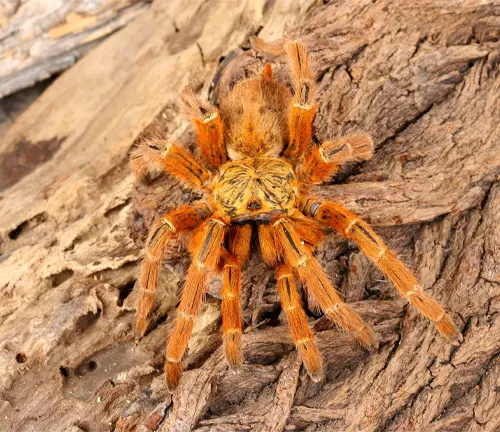
Nocturnal hunters, they actively forage for insects during the night, relying on venom injected through their fangs to subdue prey. Despite their formidable appearance, Orange Baboon Tarantulas are generally solitary creatures, only interacting with conspecifics during mating. While they are popular among exotic pet enthusiasts for their striking appearance and relatively docile nature, potential owners must exercise caution due to their defensive mechanisms. Overall, the Orange Baboon Tarantula serves as a fascinating example of the diversity and beauty of the natural world, captivating observers with its vibrant coloration and intriguing behaviors.
| Characteristic | Description |
|---|---|
| Scientific Name | Pterinochilus murinus |
| Common Name | Orange Baboon Tarantula |
| Habitat | Dry savannas, grasslands, and scrublands of central and southern Africa |
| Size | Up to 6 inches (15 centimeters) leg span |
| Coloration | Vibrant orange with contrasting black markings |
| Behavior | Nocturnal hunter, solitary, constructs underground burrows for shelter |
| Diet | Insects such as crickets, roaches, and beetles |
| Venom | Capable of subduing prey, not considered medically significant to humans unless there is an allergic reaction |
| Interaction with Humans | Relatively docile, popular among exotic pet enthusiasts, caution required due to defensive mechanisms |
| Conservation Status | Not currently threatened, but habitat destruction and collection for the exotic pet trade pose potential risks |
| Cultural Impact | Symbol of wilderness and intrigue, featured in art, literature, and popular culture |
| Notable Features | Robust body, prominent spinnerets for silk production, striking orange coloration |
| Importance in Ecosystem | Apex predator, helps regulate insect populations, contributes to biodiversity |
| Research Importance | Provides insights into arachnid biology, venom composition, potential applications in medicine and biotechnology |
| Handling in Captivity | Requires proper husbandry techniques, spacious enclosure, hiding spots, shallow water dish for hydration |
| Misconceptions | Often misunderstood as aggressive and deadly, venom primarily for subduing prey rather than causing harm to humans |
| Fascination | Captivates observers with its vibrant coloration and intriguing behaviors |
A Guide to Africa’s Striking Arachnid

The Orange Baboon Tarantula, scientifically known as Pterinochilus murinus, is a fascinating arachnid species native to the dry savannas and grasslands of central and southern Africa. Renowned for its vibrant orange coloration and impressive size, this tarantula species captivates enthusiasts and researchers alike.
Physical Characteristics
Coloration
The Orange Baboon Tarantula is renowned for its vibrant orange coloration, which covers much of its body, giving it a striking appearance. Additionally, it often features contrasting black markings, particularly noticeable on its legs. This combination of colors adds to its visual appeal and distinguishes it from other tarantula species.

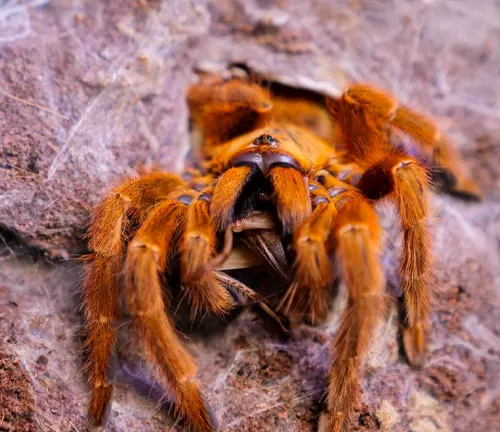
Size and Appearance
With a leg span that can reach up to 6 inches (15 centimeters), the Orange Baboon Tarantula is considered a medium to large-sized tarantula species. It boasts a robust body, with females typically larger than males. The legs are sturdy and adorned with bristles and spines, aiding in movement and defense. These tarantulas also possess prominent spinnerets, which they use to produce silk for various purposes, including constructing burrows and creating egg sacs. Overall, their appearance is both impressive and captivating, making them a favorite among tarantula enthusiasts.
Habitat and Distribution
Habitat
Orange Baboon Tarantulas are primarily found in the dry savannas, grasslands, and scrublands of central and southern Africa. They are well-adapted to arid environments and can be encountered in habitats characterized by sparse vegetation and sandy or rocky terrain. These tarantulas typically construct underground burrows for shelter, where they seek refuge from predators and harsh environmental conditions. Their burrows provide a safe haven for resting, molting, and raising offspring.
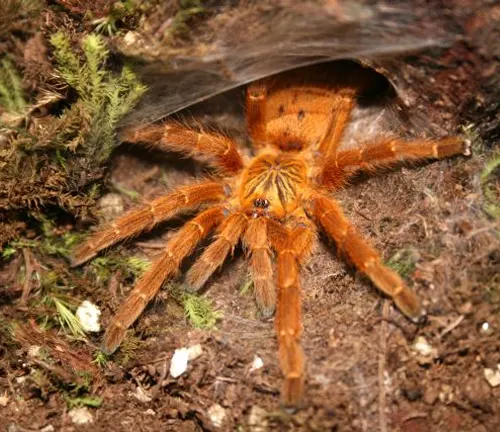

Distribution
The Orange Baboon Tarantula has a relatively wide distribution range across several countries in Africa, including Angola, Botswana, Namibia, and Zimbabwe. Within these regions, they inhabit various ecosystems, ranging from semi-desert areas to grassy plains. While they are not considered rare within their native range, their distribution may be patchy, influenced by factors such as habitat suitability and human activities. Despite their adaptability, they are primarily found in areas with dry climates and limited vegetation.
Behavior and Diet
Behavior
Orange Baboon Tarantulas are nocturnal creatures, meaning they are most active during the night. They spend their days hidden away in underground burrows, emerging at dusk to begin hunting for prey. Despite their intimidating appearance, Orange Baboon Tarantulas are generally solitary animals, preferring to lead independent lives. They are known for their cautious and defensive behavior, retreating into their burrows at the slightest hint of danger. When threatened, they may rear up on their hind legs and flick urticating hairs from their abdomens as a form of defense. Despite their solitary nature, they may interact with conspecifics during the mating season.
Diet
As carnivorous predators, Orange Baboon Tarantulas primarily feed on a diet of insects. Their menu includes a variety of prey such as crickets, roaches, beetles, and other small invertebrates that they can overpower. Using their keen senses, they detect vibrations in the ground to locate potential prey, then ambush them with lightning-fast strikes. Once captured, they use their fangs to inject venom into their prey, immobilizing it before consuming it whole. Their diet is essential for maintaining their energy levels and supporting their growth and reproduction.
Reproduction
Mating Behavior
During the mating season, male Orange Baboon Tarantulas embark on a quest to find receptive females. They use chemical cues and vibrations to locate potential mates, often traveling long distances in search of a suitable partner. Courtship rituals typically involve intricate movements and displays performed by the male to attract the female’s attention. These displays may include drumming on the ground or vibrating their abdomens in specific patterns. If the female is receptive, she may respond positively to these displays, allowing the male to approach and mate with her. However, if she rejects the male’s advances, she may display aggressive behavior or attempt to drive him away.
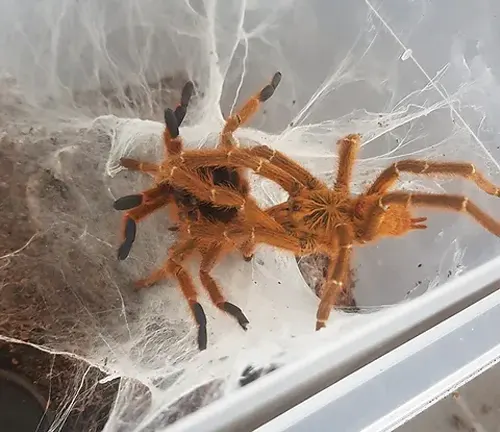
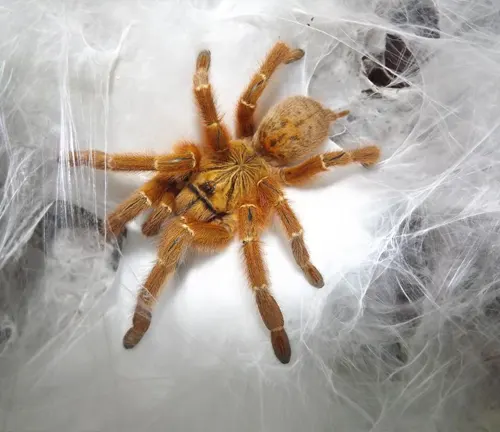
Egg-Laying and Care
After successful mating, the female Orange Baboon Tarantula begins the process of egg-laying and care. She constructs a silk-lined egg sac within her burrow or another suitable location, where she deposits her fertilized eggs. The female diligently guards the egg sac, protecting it from potential threats and ensuring its safety. She may periodically rotate or adjust the egg sac to maintain optimal conditions for the developing embryos. As the eggs near hatching, the female becomes increasingly vigilant, preparing to assist her offspring upon their emergence. Once the spiderlings hatch, they are fully independent and must fend for themselves, dispersing into the surrounding environment to begin their solitary lives.
Venom and Defensive Mechanisms
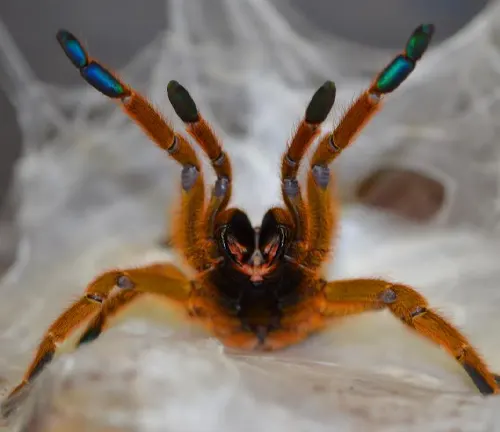
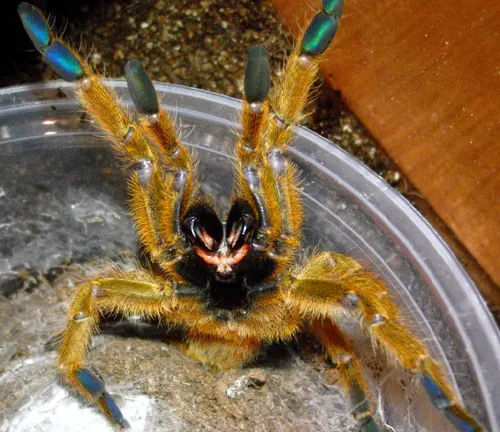
The Orange Baboon Tarantula possesses venom glands located within its chelicerae, the paired appendages that contain its fangs. While their venom is primarily used to immobilize prey, it also serves as a defensive mechanism against potential threats. When threatened, Orange Baboon Tarantulas may rear up on their hind legs and flick urticating hairs from their abdomens. These specialized hairs can cause irritation and discomfort to predators or perceived threats, acting as a deterrent. Additionally, if provoked or cornered, the tarantula may deliver a bite as a last resort. While the venom of the Orange Baboon Tarantula is potent enough to subdue small prey, it is not considered medically significant to humans unless there is an allergic reaction. In most cases, bites from Orange Baboon Tarantulas result in localized pain, swelling, and discomfort, similar to a bee sting. However, individuals who are allergic to their venom may experience more severe symptoms and should seek medical attention if bitten. Overall, Orange Baboon Tarantulas rely on a combination of venom and defensive behaviors to protect themselves from potential predators and perceived threats in their environment.
Interaction with Humans
Captivity and pet-keeping
Orange Baboon Tarantulas are popular among exotic pet enthusiasts due to their striking appearance and relatively docile nature. However, keeping them as pets requires careful consideration and adherence to proper husbandry practices. When housing Orange Baboon Tarantulas in captivity, it’s essential to provide a suitable enclosure that mimics their natural habitat. This includes providing a spacious terrarium with appropriate substrate, hiding spots, and a shallow water dish for hydration. Additionally, maintaining optimal temperature and humidity levels is crucial for their well-being. Regular feeding and monitoring of their health and behavior are also necessary to ensure they thrive in captivity. It’s important to research their specific care requirements thoroughly before acquiring one as a pet and to be prepared for the responsibilities involved in their care.
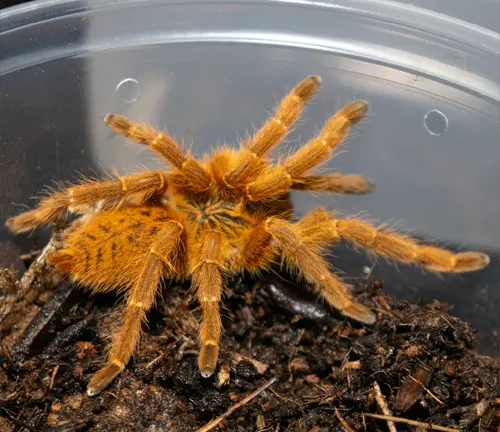
Safety Precautions
While Orange Baboon Tarantulas are generally docile and not aggressive towards humans, they possess defensive mechanisms that they may employ if they feel threatened. When handling or interacting with them, it’s essential to exercise caution and respect their boundaries. Avoid provoking or startling the tarantula, as this may lead to defensive behaviors such as rearing up on their hind legs or flicking urticating hairs. Additionally, it’s advisable to wear protective gloves and long sleeves to minimize the risk of being bitten or exposed to their irritating hairs. If bitten, clean the affected area with mild soap and water and monitor for any signs of infection or allergic reaction. Seek medical attention if necessary, especially if you experience severe symptoms or are allergic to their venom. Overall, practicing safety precautions and handling Orange Baboon Tarantulas with care is essential for both their well-being and yours when keeping them as pets.
Conservation Status
Currently, the Orange Baboon Tarantula (Pterinochilus murinus) is not considered to be globally threatened or endangered. It is not listed under any major conservation organizations’ endangered species categories, such as the International Union for Conservation of Nature (IUCN) Red List. However, like many species of wildlife, Orange Baboon Tarantulas face threats to their populations due to habitat destruction and degradation. Human activities such as deforestation, urbanization, and agricultural expansion can directly impact their natural habitat, reducing the availability of suitable habitats for these tarantulas. Additionally, collection for the exotic pet trade may pose localized threats to certain populations if not managed sustainably. While there are currently no widespread conservation efforts specifically targeting the Orange Baboon Tarantula, monitoring their populations and habitats is essential to ensure their long-term survival. Conservation initiatives aimed at preserving their natural habitats and raising awareness about their ecological importance may help mitigate potential threats and ensure the continued existence of these fascinating arachnids in the wild.
Fascination and Fear: Cultural Impact
The Orange Baboon Tarantula has long captured the human imagination, eliciting both fascination and fear in equal measure. Its striking appearance, with vibrant orange coloration and contrasting black markings, makes it a visually captivating creature that often features prominently in art, literature, and popular culture. In many societies, tarantulas, including the Orange Baboon Tarantula, symbolize wilderness and intrigue, representing the mysterious and often misunderstood world of arachnids.
However, alongside fascination, there is also a deep-seated fear of tarantulas ingrained in many cultures. This fear, known as arachnophobia, stems from the perceived threat posed by these large and hairy spiders, as well as the myths and misconceptions surrounding their venom and behavior. Despite the relatively docile nature of most tarantula species, including the Orange Baboon Tarantula, their appearance and reputation as predators can evoke fear and anxiety in those who encounter them.
Nevertheless, fascination with tarantulas persists, driven by their unique biology, behaviors, and ecological significance. Tarantula enthusiasts and researchers study these creatures to better understand their role in ecosystems and to appreciate their beauty and complexity. Through education and outreach efforts, efforts are made to dispel myths and misconceptions surrounding tarantulas and to foster a greater appreciation for these remarkable arachnids. Overall, the cultural impact of the Orange Baboon Tarantula reflects humanity’s complex relationship with nature, oscillating between fascination and fear, but ultimately contributing to a deeper understanding of the natural world.
Tips for Observing in the Wild
Tips for Observing in the Wild:
- Maintain a Safe Distance: When observing Orange Baboon Tarantulas in their natural habitat, it’s essential to maintain a respectful distance to avoid disturbing them. Use binoculars or a camera with a telephoto lens to observe from afar without causing undue stress to the spiders.
- Be Patient: Tarantulas, including the Orange Baboon Tarantula, are often elusive creatures that may spend much of their time hidden away in underground burrows. Be patient and observant, scanning the surrounding area for signs of movement or activity.
- Observe During Dusk or Night: Orange Baboon Tarantulas are nocturnal creatures, meaning they are most active during the evening and nighttime hours. Plan your observation outings accordingly, as this is when you are most likely to encounter them hunting for prey or exploring their surroundings.
- Respect Their Habitat: Avoid disturbing or damaging the natural habitat of Orange Baboon Tarantulas when observing them in the wild. Stick to designated trails and pathways, and refrain from disturbing vegetation or altering their burrows.
- Use Caution When Approaching: While Orange Baboon Tarantulas are generally not aggressive towards humans, it’s essential to approach them with caution and respect. Avoid sudden movements or loud noises that may startle them, and give them plenty of space to retreat if they feel threatened.
- Observe Without Interfering: As tempting as it may be to interact with wild tarantulas, it’s crucial to observe them without interfering with their natural behaviors. Avoid touching or handling them, as this can stress the spiders and disrupt their activities.
- Document Your Observations: Take notes and photographs of the Orange Baboon Tarantulas you encounter in the wild, recording details such as location, behavior, and habitat. This information can contribute to scientific research and conservation efforts aimed at protecting these fascinating arachnids and their ecosystems.
Handling and Caring for Captive Tarantulas
Handling and Caring for Captive Tarantulas:
- Choose the Right Enclosure: Select a suitable terrarium or enclosure for your tarantula, ensuring it provides enough space for the spider to move around comfortably. Opt for a well-ventilated enclosure with secure lid to prevent escapes.
- Provide Proper Substrate: Use appropriate substrate, such as coconut fiber or peat moss, to create a naturalistic environment for your tarantula. The substrate should be deep enough for the tarantula to burrow if desired, and it should hold moisture well without becoming waterlogged.
- Maintain Optimal Temperature and Humidity: Tarantulas, including the Orange Baboon Tarantula, thrive in environments with stable temperatures and humidity levels. Keep the terrarium at temperatures ranging from 70°F to 85°F (21°C to 29°C) and maintain humidity levels between 65% to 75%. Use a hygrometer to monitor humidity levels and a thermostat to regulate temperatures.
- Provide Hiding Places: Offer hiding spots such as half logs, cork bark, or artificial shelters for your tarantula to retreat to when feeling stressed or threatened. These hiding places also serve as anchor points for webbing and molting sites.
- Offer Fresh Water: Provide a shallow water dish filled with fresh, chlorine-free water for your tarantula to drink from. Change the water regularly to prevent contamination and ensure cleanliness.
- Feed Appropriately: Offer your tarantula a varied diet of live prey insects such as crickets, roaches, mealworms, and superworms. Feed adult tarantulas approximately once or twice a week, while juveniles may require more frequent feedings to support their growth.
- Handle with Caution: While handling tarantulas is not necessary and should be avoided unless absolutely necessary, if you must handle your tarantula, do so with extreme caution. Use soft paintbrushes or long forceps to gently coax the tarantula into moving rather than using your hands. Avoid handling during molting or when the tarantula is in a defensive posture.
- Monitor Health and Behavior: Regularly observe your tarantula for signs of health issues such as lethargy, loss of appetite, or abnormal behaviors. Seek veterinary care if you notice any concerning symptoms.
Myths and Misconceptions
Myths and Misconceptions:
- Tarantulas are Deadly: One of the most prevalent myths is that tarantulas, including the Orange Baboon Tarantula, are deadly to humans. In reality, while tarantula venom can cause localized pain, swelling, and discomfort, it is not considered life-threatening to humans unless there is an allergic reaction. Tarantula bites are rarely fatal, and most cases result in symptoms similar to a bee sting.
- Tarantulas are Aggressive: Another misconception is that tarantulas are aggressive and prone to attacking humans. In truth, tarantulas are generally docile creatures that prefer to retreat rather than confront threats. They will typically only bite as a last resort if they feel threatened or cornered.
- Tarantulas are Highly Venomous: While tarantula venom is potent enough to subdue their prey, it is not as toxic as commonly believed. Tarantula venom primarily serves to immobilize small insects and is not designed to cause harm to humans. Most tarantula bites result in mild symptoms that resolve on their own without medical intervention.
- Tarantulas are Lethal to Pets: There is a misconception that tarantulas pose a significant threat to pets such as cats and dogs. While interactions between tarantulas and pets should be monitored to prevent injury, most pets are unlikely to be seriously harmed by tarantula venom. However, caution should still be exercised, especially with smaller animals.
- All Tarantulas are the Same: Many people believe that all tarantulas are similar in behavior and appearance. In reality, there is a wide variety of tarantula species, each with its own unique characteristics and behaviors. For example, the Orange Baboon Tarantula has distinct coloration and behaviors compared to other tarantula species.
- Tarantulas are Dirty and Disease-Carrying: Contrary to popular belief, tarantulas are not inherently dirty or disease-carrying creatures. With proper care and husbandry, captive tarantulas can be kept in clean and hygienic conditions. Tarantulas groom themselves regularly to remove debris and maintain cleanliness
Research and Scientific Importance
Research and Scientific Importance:
- Behavioral Studies: Orange Baboon Tarantulas, like other tarantula species, exhibit fascinating behaviors that are of interest to researchers. Studying their behavior in both natural and captive settings can provide insights into their social interactions, hunting strategies, mating rituals, and communication methods.
- Venom Composition: The venom of tarantulas, including the Orange Baboon Tarantula, contains a complex mixture of toxins with potential biomedical applications. Research into the composition and properties of tarantula venom can lead to the development of new drugs and therapies for various medical conditions, including pain management and neurological disorders.
- Ecological Role: Tarantulas play a crucial role in their ecosystems as apex predators, helping to regulate insect populations and maintain ecological balance. Researching their ecological interactions and habitat requirements can contribute to our understanding of ecosystem dynamics and inform conservation efforts aimed at preserving their natural habitats.
- Evolutionary Studies: Tarantulas are ancient creatures that have evolved unique adaptations to survive in diverse environments. By studying their evolutionary history and genetic diversity, researchers can gain insights into the evolutionary processes that have shaped tarantula morphology, behavior, and ecological niches over millions of years.
- Biotechnology Applications: Tarantula silk is known for its strength and elasticity, making it a valuable material for various biotechnological applications. Research into tarantula silk production and properties can lead to the development of novel biomaterials for use in industries such as textiles, medicine, and engineering.
- Conservation Biology: Understanding the population dynamics, distribution, and habitat requirements of the Orange Baboon Tarantula is essential for its conservation. Research into factors affecting tarantula populations, such as habitat loss, climate change, and human activities, can inform conservation strategies and management practices aimed at protecting these iconic arachnids and their ecosystems.
Different Species
Pterinochilus chordatus
This species, also known as the Kilimanjaro Mustard Baboon Tarantula, is native to Tanzania and is characterized by its mustard-yellow coloration with black markings.
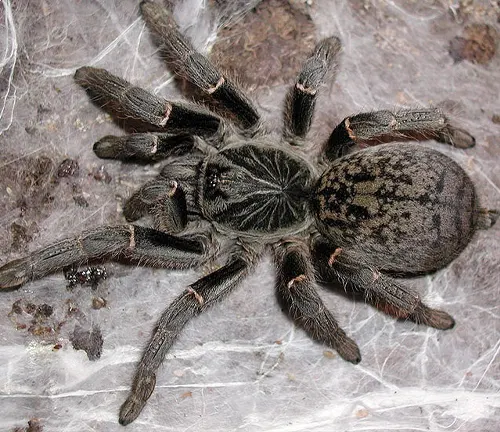
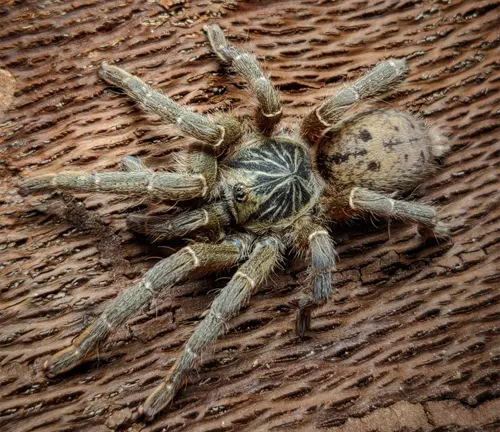
Pterinochilus lugardi
Commonly known as the Usambara Orange Baboon Tarantula, this species is found in the Usambara Mountains of Tanzania. It exhibits a vibrant orange coloration similar to P. murinus but with distinct patterning.
Pterinochilus mamillatus
Found in Mozambique and Zimbabwe, the Zimbabwe Orange Baboon Tarantula displays a rich orange coloration with prominent black markings on its legs and abdomen.
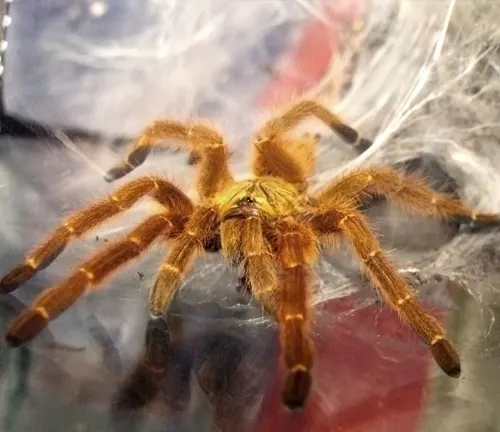
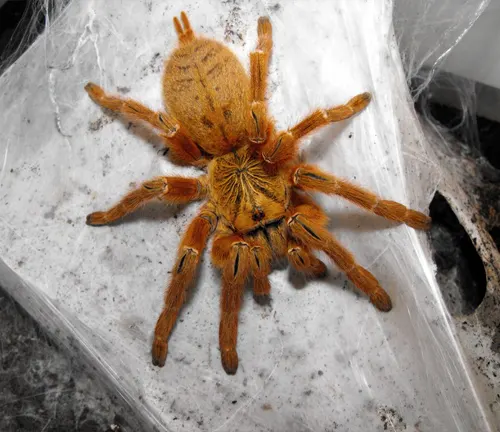
Pterinochilus meridionalis
This species, also referred to as the Angolan Orange Baboon Tarantula, hails from Angola and showcases a deep orange coloration with intricate black patterning.
Pterinochilus lugardi “Mombasa Golden Starburst”
A variant of P. lugardi, this morph is known for its brilliant golden-orange coloration and is highly sought after by tarantula enthusiasts.

Frequently Asked Questions (FAQs)
- Are Orange Baboon Tarantulas aggressive?
While they can display defensive behaviors if threatened, Orange Baboon Tarantulas are generally not aggressive towards humans and will typically retreat rather than attack. - What do Orange Baboon Tarantulas eat in the wild?
In their natural habitat, Orange Baboon Tarantulas primarily feed on insects such as crickets, roaches, beetles, and other small invertebrates. - How often do Orange Baboon Tarantulas molt?
The frequency of molting can vary depending on factors such as age, gender, and environmental conditions, but on average, Orange Baboon Tarantulas molt approximately once every few months as they grow. - What is the typical temperament of Orange Baboon Tarantulas as pets?
While individual temperament can vary, Orange Baboon Tarantulas are generally known for their relatively docile nature compared to other tarantula species, making them suitable pets for experienced keepers. - Can Orange Baboon Tarantulas be housed together in captivity?
It is not recommended to cohabitate Orange Baboon Tarantulas, as they are solitary creatures by nature and may exhibit territorial and aggressive behaviors towards one another. - Do Orange Baboon Tarantulas require special heating or lighting in captivity?
Orange Baboon Tarantulas do not require additional heating or lighting beyond room temperature conditions, but it is essential to provide a suitable environment with proper substrate, humidity, and ventilation. - What substrate is best for housing Orange Baboon Tarantulas?
Substrates such as coconut fiber, peat moss, or a mixture of both are suitable for Orange Baboon Tarantulas, providing a naturalistic environment while retaining moisture. - How often should I feed my Orange Baboon Tarantula in captivity?
Adult Orange Baboon Tarantulas can be fed approximately once or twice a week, while juveniles may require more frequent feedings to support their growth. - Can Orange Baboon Tarantulas climb glass or smooth surfaces?
While they are not adept climbers compared to some arboreal tarantula species, Orange Baboon Tarantulas may still attempt to climb smooth surfaces, so it’s essential to provide secure enclosures with appropriate lids. - Are there any legal restrictions on keeping Orange Baboon Tarantulas as pets?
Regulations regarding the ownership and keeping of Orange Baboon Tarantulas may vary depending on location, so it’s advisable to check local laws and regulations before acquiring one as a pet.


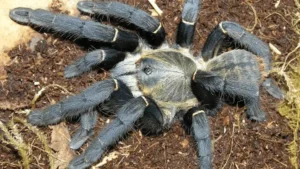
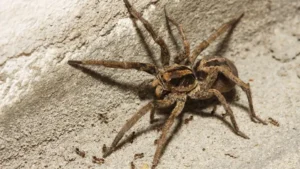
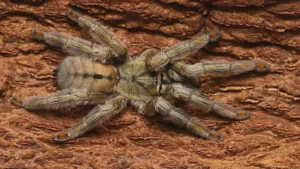

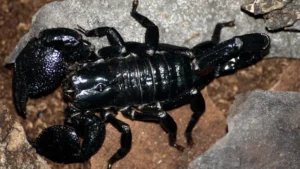
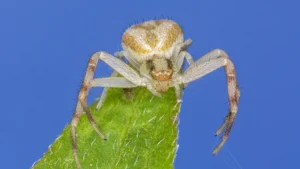



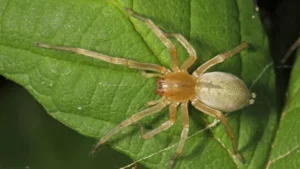


Leave your comment